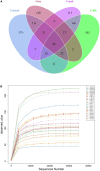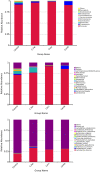Effects of challenge with Clostridium perfringens, Eimeria and both on ileal microbiota of yellow feather broilers
- PMID: 36532499
- PMCID: PMC9754095
- DOI: 10.3389/fmicb.2022.1063578
Effects of challenge with Clostridium perfringens, Eimeria and both on ileal microbiota of yellow feather broilers
Abstract
In the poultry industry worldwide, Clostridium perfringens has been causing major economic loss as it can cause necrotic enteritis (NE). The coccidial infection has been considered as the most important predisposing factor of NE caused by C. perfringens. In this study, we aimed to advance our knowledge on ileal microbiota of yellow feather broilers under C. perfringens and/or Eimeria challenge. Total of 80 healthy day old yellow feather broilers were randomly assigned to four groups including: Control, C. perfringens challenge group (C. Per), Eimeria challenge group (Cocc), and C. perfringens plus Eimeria challenge group (Comb). On day 14, the Cocc and Comb group broilers were orally gavaged 1 ml PBS solution containing 25,000 oocysts of Eimeria brunetti and 25,000 oocysts of Eimeria maxima. Starting on day 17, the C. Per and Comb group broilers were orally gavaged 10 mL of C. perfringens per bird (4 × 107 CFU/mL, ATCC® 13124™ Strain) every day for 6 days. 16S rRNA gene sequencing was performed on extracted DNA of ileal digesta samples. The results showed that C. perfringens alone did not affect the alpha diversity of ileal microbiome in yellow feather broilers but co-infection with Eimeria significantly decreased the diversity of ileal microbiota. C. perfringens and Eimeria challenge also decreased the relative abundance of beneficial bacteria including Bacteroidetes at the phylum level and Faecalibacterium at the genus level. At the species level, the relative abundance of Candidatus Arthromitus was significantly decreased in the Eimeria challenged groups. This microbial shift information of ileal microbiota under C. Perfringens and Eimeria challenge provide important reference data for the development of therapeutic approaches to necrotic enteritis in yellow-feather broiler chickens.
Keywords: C. perfringens; Eimeria; challenge; microbiota; yellow feather broiler.
Copyright © 2022 Feng, Li, Zhu, Liu, Bi, Chen and Zhang.
Conflict of interest statement
Author LL was employed by Foshan Zhengdian Biology Technology Co., Ltd. The remaining authors declare that the research was conducted in the absence of any commercial or financial relationships that could be construed as a potential conflict of interest.
Figures





Similar articles
-
Effect of different challenge models to induce necrotic enteritis on the growth performance and intestinal microbiota of broiler chickens.Poult Sci. 2019 Jul 1;98(7):2800-2812. doi: 10.3382/ps/pez084. Poult Sci. 2019. PMID: 30877749
-
Effects of Eimeria challenge on growth performance, intestine integrity, and cecal microbial diversity and composition of yellow broilers.Poult Sci. 2024 Dec;103(12):104470. doi: 10.1016/j.psj.2024.104470. Epub 2024 Oct 31. Poult Sci. 2024. PMID: 39504824 Free PMC article.
-
Efficacy of an attenuated vaccine against avian coccidiosis in combination with feed additives based on organic acids and essential oils on production performance and intestinal lesions in broilers experimentally challenged with necrotic enteritis.Poult Sci. 2022 Jun;101(6):101848. doi: 10.1016/j.psj.2022.101848. Epub 2022 Mar 15. Poult Sci. 2022. PMID: 35544960 Free PMC article.
-
Microbial shifts associated with necrotic enteritis.Avian Pathol. 2016 Jun;45(3):308-12. doi: 10.1080/03079457.2016.1152625. Avian Pathol. 2016. PMID: 26950294 Review.
-
Necrotic enteritis predisposing factors in broiler chickens.Avian Pathol. 2016 Jun;45(3):275-81. doi: 10.1080/03079457.2016.1150587. Avian Pathol. 2016. PMID: 26926926 Review.
Cited by
-
Natural intraepithelial lymphocyte populations rise during necrotic enteritis in chickens.Front Immunol. 2024 Feb 22;15:1354701. doi: 10.3389/fimmu.2024.1354701. eCollection 2024. Front Immunol. 2024. PMID: 38455042 Free PMC article.
-
Alpha toxin production potential and antibiotic resistance patterns of clostridium perfringens isolates from meat samples.Anim Biosci. 2024 Nov;37(11):1970-1978. doi: 10.5713/ab.24.0210. Epub 2024 Jun 25. Anim Biosci. 2024. PMID: 38938034 Free PMC article.
-
Evaluating the protective effects of the Toll-like receptor (TLR) 21 ligand, CpG ODN, against necrotic enteritis in broiler chickens.PLoS One. 2025 Mar 13;20(3):e0319404. doi: 10.1371/journal.pone.0319404. eCollection 2025. PLoS One. 2025. PMID: 40080496 Free PMC article.
-
Phytogenics in Ginger, Origanum vulgare, and Syzygium aromaticum and Their Potential as a Feed Additive against Clostridium perfringens in Broiler Production.Animals (Basel). 2023 Nov 24;13(23):3643. doi: 10.3390/ani13233643. Animals (Basel). 2023. PMID: 38066994 Free PMC article. Review.
-
Temporal Changes in Jejunal and Ileal Microbiota of Broiler Chickens with Clinical Coccidiosis (Eimeria maxima).Animals (Basel). 2024 Oct 15;14(20):2976. doi: 10.3390/ani14202976. Animals (Basel). 2024. PMID: 39457906 Free PMC article.
References
-
- Al-Shaer B. M., Al-Batshan H. A., Al-Atiyat R. M. (2019). Effect of probiotics on diversity of bacterial community in the gastrointestinal tract of chickens. Singapore J. Sci. Res. 9 86–94.
-
- Baba E., Wakeshima H., Fukui K., Fukata T., Arakawa A. (1992). Adhesion of bacteria to the cecal mucosal surface of conventional and germ-free chickens infected with Eimeria tenella. Am. J. Vet. Res. 53 194–197. - PubMed
LinkOut - more resources
Full Text Sources
Other Literature Sources

